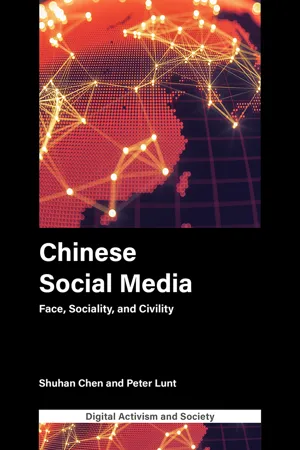Languages & Linguistics
Concept of Face
The concept of "face" in sociolinguistics refers to the public image or social identity that individuals maintain in interactions. It involves the desire to be respected and valued by others, and the strategies used to uphold this image. Face-saving and face-threatening acts are central to this concept, influencing communication and social dynamics.
Written by Perlego with AI-assistance
5 Key excerpts on "Concept of Face"
Learn about this page
Index pages curate the most relevant extracts from our library of academic textbooks. They’ve been created using an in-house natural language model (NLM), each adding context and meaning to key research topics.
- eBook - ePub
Language As Social Action
Social Psychology and Language Use
- Thomas M. Holtgraves(Author)
- 2013(Publication Date)
- Psychology Press(Publisher)
In terms of the weighting of the variables, Holtgraves and Yang (1992) and Ambady et al. (1996) have demonstrated that South Koreans weight the power and distance variables more heavily than do U.S. Americans. This means that South Koreans tend to vary the politeness of their remarks as a function of power and distance to a greater extent than do U.S. Americans. This is an important finding and one that dovetails nicely with the concept of indivi- dualism-collectivism. In collectivist cultures such as Korea, strong distinctions are drawn between in-groups and out-groups, and this results in greater overall variability in social interaction (Gudykunst, Yoon, & Nishida, 1987; Leung, 1988; Wheeler, Reis, & Bond, 1989). Hence, the findings for politeness are consistent with the overall pattern of greater behavioral responsiveness to social situations for collectivists relative to individualists. Another possibility in this regard has been suggested by Ting-Toomey (1988), who has argued that the politeness of people in collectivist cultures focuses more on other-face, while the politeness of people in individualistic cultures focuses more on self-face.The concepts of face and face-work have great utility in terms of explaining the patterning of language behavior over contexts. Is face a universal concept? Possibly. Do people in all cultures have both positive and negative face wants? Possibly, but they will probably be weighted differently. Do acts threaten face in the same way in all cultures? Definitely not. The specific manifestations of face threat show great cultural and subcultural variability. Again, with politeness theory we are at a relatively high level of abstraction, a level that provides a framework for explaining cross-cultural similarities and differences in language use. And the importance of such a framework should not be underestimated. Examining cross-cultural variability in language use without such a framework would result in a purely descriptive enterprise, a listing of features that appear to be cross-culturally different, but which at a higher level may reflect similar underlying motivations. Now, one problem with the theory, as with any broad theoretical enterprise (e.g., Freudian psychoanalytic theory), is that it may border on the non-falsifiable. For example, failing to confirm politeness theory predictions in one culture can be explained away by arguing that face was manifested differently in that culture. Obviously, specification of the manifestations of face within a culture needs to be undertaken before the theory can be tested within that culture.POLITENESS AND COMPREHENSION
As the preceding review suggests, politeness is a pervasive and universal feature of human language use, and research has demonstrated how it motivates the manner in which people phrase their utterances in different settings. But what about language comprehension? If politeness impacts language production, should it not also play a parallel role in language comprehension? This possibility has received only limited attention; politeness research has focused almost exclusively on language production. Still, there are some possibilities worth mentioning. - eBook - ePub
Chinese Social Media
Face, Sociality, and Civility
- Shuhan Chen, Peter Lunt(Authors)
- 2021(Publication Date)
- Emerald Publishing Limited(Publisher)
(Goffman, 1967, p. 19)Just as in his analysis of self-presentation, Goffman (1967) acknowledges the fragility of this process of mutual face recognition dependent on social skills which include a range of techniques for handling threats to face. Brown and Levinson (1987) take up this idea in their study of politeness, echoing both Goffman and the Chinese Concept of Face. They define face as ‘something that is emotionally invested, and that can be lost, maintained, or enhanced, and must be constantly attended to in interaction’ (Brown & Levinson, 1987, p. 61). They also distinguish between positive and negative face: ‘positive face’ refers to self-esteem, the desire to have a positive self-image to be liked and respected; ‘negative face refers to the desire to act freely without restriction from others’. Brown and Levinson (1987, p. 83) also claim that their theory of politeness reflects universal principles and that the practice of these principles ‘differs systematically across cultures, and within cultures across subcultures, categories and groups’.Chinese Face Concepts
Ho (1976, p. 883) defines face as:… the respectability and/or deference which a person can claim for himself/herself from others, by virtue of the relative position he/she occupies in his/her social network and the degree to which he/she is judged to have functioned adequately in that position as well as acceptability in his/her general conduct… Face is the reciprocated compliance, respect, and/or deference that each party expects from, and extends to, the other party.There are differing accounts of the key characteristics of face in Chinese culture. For example, face as reflecting moral and social character (Hu, 1944); as reciprocity and relational character (Ho, 1976); and as reflecting principles of social exchange (Hwang, 2006). Definitions of face change over time, although there is consensus on certain aspects of face. The Chinese Concept of Face is akin to an invisible hand that controls the lives of the Chinese yet is difficult to define (Lin, 1935). It ‘is abstract and intangible, it is yet the most delicate standard by which Chinese social intercourse is regulated’ (Lin, 1935, p. 45). Instead of providing a precise definition of the Chinese Concept of Face, Chang (2008, p. 303) argues that the ‘Chinese Concept of Face is a conceptualisation of a competent person in Chinese society’. What emerges is that lian is not a universal ‘birth right’, but an articulation of the minimum standard by which individuals are judged to be socially competent beings. Complementing this, the link between lian - eBook - ePub
Patient-centred Communication
Discourse of In-home Medical Consultations for Older Adults
- Kayo Kondo(Author)
- 2022(Publication Date)
- Multilingual Matters(Publisher)
Similarly, Gu (1990) alleged that the Chinese notion of negative face, in situations of offering, inviting and promising, is different from that assumed in the framework proposed by Brown and Levinson and that exercising politeness strategies is not just an interactional instrument but also a normative phenomenon (1990: 242). Mao (1994) explained that the Chinese Concept of Face does not privilege the ‘self’ as much as Brown and Levinson’s definition of face does. Rather, it represents a self-image that is linked to the views of the community, not individuals’ wants towards themselves. Chinese face thus emphasises the harmony of individual behaviours with the judgement of the community rather than individuals’ desires (1994: 460).Ide et al. (1992) investigated how the term ‘polite’ and ‘friendly’ is conceptualised as against their American counterparts. For American students, the term ‘polite’ was correlated closely with ‘friendly’. By contrast, these two adjectives fell into far different dimensions among Japanese students when applied to cross-culturally equivalent situations. The Japanese adjective ‘teineina (polite)’ involved the speaker’s sense of distance towards the hearer, the expression of which is conveyed by honorifics. On the other hand, ‘shitashigena (friendly)’ indicates the speaker’s sense of intimate attitude, which is often associated with the use of informal style or additional final particles along with honorifics (the use of an additional final particle functions as shortening the psychological distance between the speaker and hearer, in other words, it is ‘a marker of familiarity’). It was argued that the use of honorifics is conventionally appreciated, even in a friendly relationship.As shown above, honorifics and a marker of familiarity co-occur in the same sentence. Ide (1989) claimed that the sequence of linguistic choice projects the ‘relative rank’ of the participants and the speaker’s adherence to the social norms and behaviours expected by others. This, however, is slightly contradictory, because holding both contrasting nuances in one utterance can indicate mitigating an FTA towards the speaker. The informal style – a marker of familiarity – functions as softening the rigidness of the formality. Matsumoto (1988) and Ide (1989) explained the characteristics of the Japanese language system, arguing that ‘choice’ is almost obligatory when it is based on the social norm. Ide (1989: 230) proposed a term, wakimae , which is an aspect that Brown and Levinson neglected. The practice of polite behaviour according to social conventions is known as wakimae in Japanese. To behave according to wakimae - eBook - ePub
Language, Society, and New Media
Sociolinguistics Today
- Marcel Danesi(Author)
- 2020(Publication Date)
- Routledge(Publisher)
distant one.Individuals who speak Italian as a native language tend to experience not only an emotional allegiance to Italian culture and society, but also to see themselves as different from others (whether or not this is sustainable). But LIs are highly variable. For one thing, LI is experienced differently in subsequent generations. Moreover, in cyberspace, the linguistic rules of identity formation have changed, as LIs are being constructed not only through the traditional “real” social structures of the world (including rearing and upbringing), but also through Self-construction strategies. A Facebook profile is a case-in-point, which includes not only basic background information about oneself (work, education, and so on), but also presentations of oneself (relationship status, significant life events, and so on). The way these are written and narrated allows users to recreate their offline identities in specific ways.5.2.1 TheoriesSifting through the literature on identity in the social and cognitive sciences, one finding stands out: it evolves primarily during two periods in the lifecycle—in childhood and at adolescence. In the former, identity can be designated as an “indexical” system of Self-awareness, because it is imparted to children by and through the environment in which they are reared and, thus, in reference to it. The specific language and cultural codes (art, music, and so on) in the child’s rearing environment constitute the indexical resources through which the child comes to develop an unconscious sense of Selfhood. The form of identity that emerges at puberty, in contrast, can be called “symbolic,” because the adolescent interprets the world more consciously and adapts to it symbolically, that is, through symbolic resources such as slang and lifestyle. But in both stages—childhood and adolescence—it is through interaction with others from which one’s sense of identity arises. It is largely unconscious in childhood, because it is imparted through situational factors (indexical); whereas it is conscious, or at least intentional, in the coming-of-age period (symbolic). The shifts in identity that come about subsequent to adolescence through job choices, education level, marriage, and other events need not concern us here. - eBook - ePub
Second Language Pragmatics
From Theory to Research
- Jonathan Culpeper, Alison Mackey, Naoko Taguchi(Authors)
- 2018(Publication Date)
- Routledge(Publisher)
The loss of face often results in humiliation or embarrassment, a fact that hints at the emotional sensitivity of face. Goffman’s (1967) definition of face is frequently cited: [T]he positive social value a person effectively claims for himself by the line others assume he has taken during a particular contact. Face is an image of self-delineated in terms of approved social attributes. (p. 5) This is partially echoed in Brown and Levinson’s (1987) scheme, which consists of two related components of face. “Positive face” is defined, echoing Goffman, as follows: “the want of every member that his wants be desirable to at least some others … in particular, it includes the desire to be ratified, understood, approved of, liked or admired” (p. 62). “Negative face,” which has no obvious echo in Goffman, is defined as “the want of every competent adult member that his actions be unimpeded by others” (p. 62). Note: the terms positive and negative do not refer to good and bad evaluations. Face is couched in terms of psychological “wants,” and they also assume these to be universal: “every member wants to claim for himself” (p. 61). With Goffman, as can be seen in the above quotation, it is not just the positive values that you yourself want, but what you can claim about yourself from what others assume about you. When you lose face, you feel negatively about how you are seen in other people’s eyes. This important social interdependence has been stripped out of Brown and Levinson’s definition. Also, the general focus on the individual seems to ignore cases where the positive attributes apply to a group of people (e.g., a winning team), or where an imposition on yourself is not the main concern, but rather it is how you stand in relation to a group (e.g., whether you are afforded the respect associated with your position in the team)




